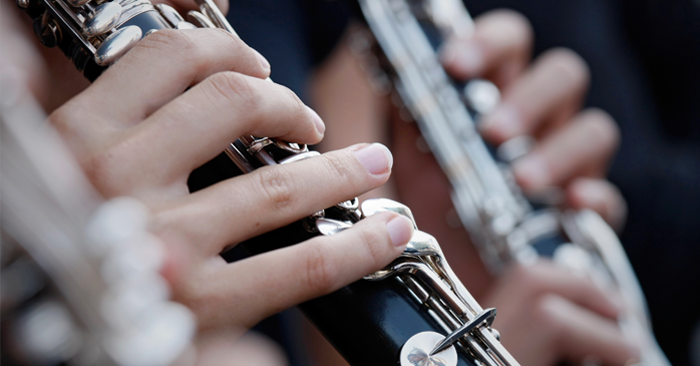
Back to school season is here, and it’s time to start planning your first few weeks of school. Here are some things to keep in mind when building lesson plans for clarinet and sax students as you begin your year.
Three Things for Year One, Week One
Getting beginners off to a strong start makes a better first impression for students and parents, and saves you valuable time later by teaching good habits from the beginning. Here are three things to focus on in the first week.
1. Embouchure Pressure
I think the most confusing thing for beginning single reed players is embouchure pressure. Beginning students will ask questions like:
- “Is my chin pointed down or is my lip going up?”
- “How do I know if I’m biting?”
- “I keep leaking out of the corners of my mouth!”
The answer to all of these questions has to do with maintaining even embouchure pressure — a critical skill for single reed playing. You can say “equal pressure all the way around” and draw diagrams with arrows pointing in all directions around a mouth, but sometimes that just doesn’t click with students.
I picked up a great strategy for tactile learners from Daniel Silver at the University of Colorado that’s proven really effective with beginners. Hand out Chinese finger traps to students to demonstrate how the pressure is even all the way around their fingers and also that more pressure isn’t always better (more struggling won’t get you out of those things unless you’re The Hulk). This physical comparison can help students understand that their embouchures should be snug all the way around and get good embouchures started right away.
2. Reed Strength
It’s tempting to start students on a soft reed to make it easier to create sound right off the bat, but that can lead to bad habits. Start students on a number 2 strength reed — if a student can’t make that reed vibrate, there is something going on with the embouchure, probably biting. I prefer Vandoren reeds; they are a bit thicker than other brands, so students end up with a fuller sound and get a feel for appropriate resistance rather than blasting away on something that’s far too soft.
By Thanksgiving or Christmas students should have the air and embouchure stability to move up a half strength. In general, if the sound is blasting and unfocused, the student probably has enough air for a stronger reed, and if the sound is thin and airy with a red-faced student, the reed is probably too hard or warped. Be sure to give students clear instructions on reed care as well.
3. Instrument Anatomy
It may seem obvious, but students need to know all the parts of their instruments. I have come across students at the end of their middle school careers who call the ligature “the thing that holds the reed on.” Students should also know the note names for each fingering. When “it” or “this one” won’t play, it takes more class time to diagnose than when “low F is having a hard time coming out.” If you have time, a fun “Pin the Tail on the Donkey” style game, sans blindfolds, where students match parts and names might help things stick, literally and figuratively.
Three Tips for Returning Students
Helping your older students shake the summer rust off is another important beginning of the year task. Our stronger students may have had a great summer practice schedule, but getting everyone back up to speed will result in more productive rehearsals.
1. The Right Tools
You’ve probably already checked over school instruments and had them repaired, but students who own their instruments may not have been too kind to their instruments over the summer. Take the time and check over those instruments too since neglect can cause problems. If a wooden clarinet has been sitting in the case in a sunny window all summer, you may have some surprises coming. Cases are great, but your saxophone can still end up with a slightly bent (and therefore leaky) key if it’s been tossed around in a car trunk. Also, those reeds are going to be at best dry and warped after a lonely summer. Make sure your students have at least three new reeds each and toss out anything with mold(!)
2. The Right Pace
Pushing too hard too soon will do more damage than good. New technique issues can suddenly appear in students’ playing after long breaks if we aren’t careful. Students can develop biting problems when they use jaw pressure to compensate for exhausted embouchures and poor air control. If you do notice students biting, try encouraging them to put as much space between their noses and chins as possible. You could also try (very brief) double-lip exercises where both the top and bottom lips cover the teeth.
Tension in hands and arms from tired muscles can cause jerky technique, which will set you back in the long run rather than getting a jump on the school year during camp. Watch your students and give breaks when you see signs of fatigue. For embouchure, these can include puffed cheeks, extremely unfocused or goose-like tone, air leaking out around the mouthpiece, and in extreme cases vibrato or even buzzing at the corners of students’ mouths. For tired hands and forearms, you may notice uneven technique and students shaking out or massaging their arms and hands.
Of course, just because you’re not playing doesn’t mean you’re wasting time. Use breaks to play recordings and ask students questions about style, balance, how the music integrates with the drill, and important differences between the source material and the show arrangement. Critical thinking and analysis can start on day one. Also remember to drink water, especially if you’re outdoors.
3. The Right Warm-up
When students return from summer they are likely to have weak tone production, uneven technique, and low endurance, but exercises included in a thorough warm-up will address all three of those troubles. Start with stretching and breathing exercises to make sure students are getting enough air in to begin with. “The Breathing Gym” is a fantastic resource if you’re looking for specific exercises. I’m particularly fond of those that focus on taking full breaths in and out for a specified number of beats, which will help with get students’ internal metronomes going for the day at the same time they’re waking up their cores.
Then go through some moderately slow scales and arpeggios to get the fingers working. Many All-State lists will include some kind of technique requirement, so starting your students on those in August will help them feel more confident by the time auditions come around. For clarinet, the Klosé book is a favorite (and on imslp.org), and you might find the short exercises on page 22-23 especially helpful in working out uneven fingers. You may even find that it works well for all your woodwinds if you have time to transpose. For saxophone, take a look through “Universal Method for Saxophone” by Paul Deville and you’ll be certain to find something obliging.
Make sure your students are listening for a characteristic tone and fluid, even, connected lines. Finally, wake up those ears with some Bach chorales. I love using these to teach listening for balance and tuning. It’s easy for single reeds to sound like the barn cats are killing the pond geese, especially if you just dive into the show music. A really strong warm-up will tame the farm animals.
I hope these thoughts help you as you dive into the new school year.
 Maggie Greenwood directs the woodwind studios and orchestras at the Colorado School of Mines.
Maggie Greenwood directs the woodwind studios and orchestras at the Colorado School of Mines.
An active teacher, clinician and performer in the Denver area, she holds the Master of Music degree in clarinet performance from the University of North Texas, where she studied with Daryl Coad.